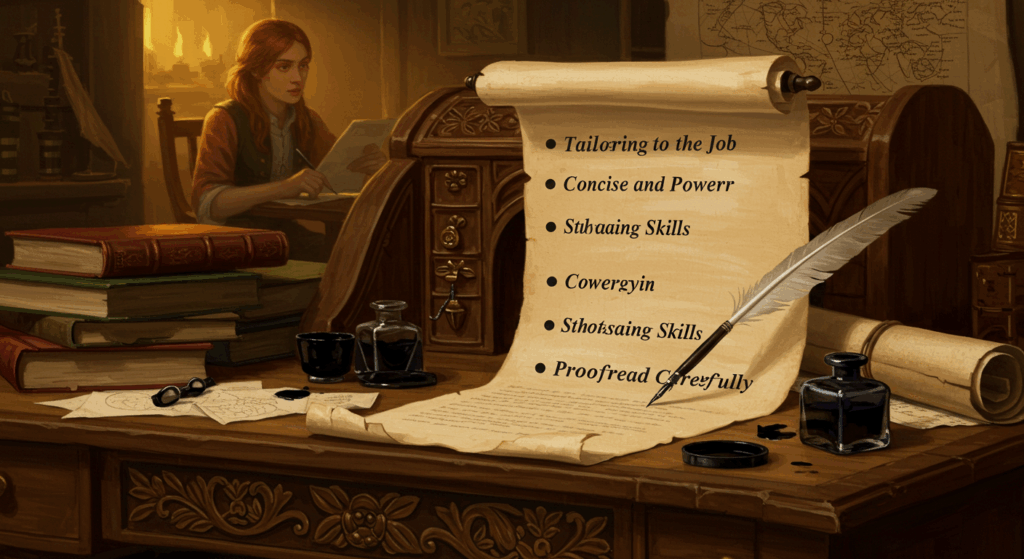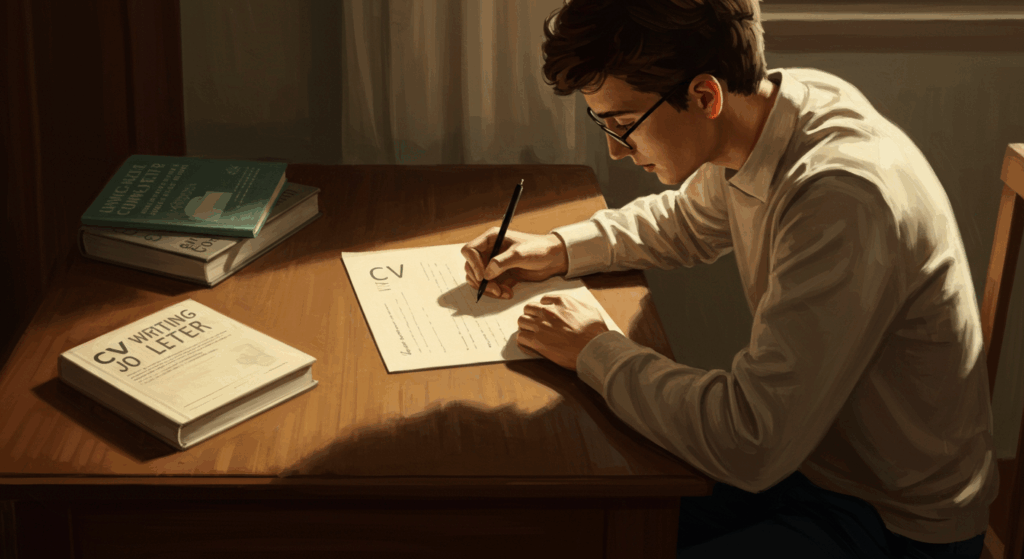From Someone Who’s Been There, Sweated That
Okay, you see, cover letters feel like homework from a teacher who says “it builds character.” You’ve already poured your soul into a resume, your LinkedIn is like… fine, and now someone wants a mini essay about why you’re awesome? Ugh. But here’s the thing—done right, a cover letter isn’t busywork. It’s your chance to sound like a whole human, not just a list of bullet points. Think of it as a quick DM to the hiring manager where you say, “Hey, I get your vibe, here’s proof I can do the thing, and btw I’m cool to work with.”
In this guide, I’m sharing cover letter advice that’s actually practical, mixing writing tips with very real do’s and don’ts (and some “I learned this the hard way” moments). We’ll keep it casual, sprinkle jokes where it makes sense, and by the end, you’ll have a letter that sounds like you—just, like, the best version of you after coffee and a power playlist.
Also, quick vibe check: I’ll use the phrases “cover letter advice,” “writing tips,” and “do’s and don’ts” naturally because, SEO gods. But we’re not keyword stuffing—we’re vibing.
What a Cover Letter Is (and Isn’t)
Here’s the simplest definition that won’t make your eyes glaze over:
- A cover letter is a short story about why you + this job = win.
- It’s not a resume recap, a memoir, or a generic “To whom it may concern” essay from 2003.
- It should connect dots the resume can’t: your motivation, your values, the why now, and the why them.
If your resume shows what you’ve done, your cover letter shows what you’re like to work with—and why you care. Hiring managers read between the lines: Are you thoughtful? Do you get the company’s vibe? Can you communicate like a human? That’s why this matters.
The 7-Second Rule: Hook Fast, Hook Real
People scan. That’s just life. If your opening feels like a wall of blah, the reader’s brain goes 💤. So the first 2–3 lines need to do work.
Three Opening Styles That Slap
- The “I See You” Opener (aka Company-Love Intro)
“I’m applying for the Social Media Manager role because your ‘Year in Memes’ campaign basically lived rent-free in my head all summer. You didn’t just chase trends—you started them. That’s the strategy I want to help scale.” - The “Proof First” Opener (aka Not-So-Humble Brag)
“Last quarter, my email series drove a 31% lift in trial-to-paid conversions. I’m excited to bring that test-and-learn energy to your Lifecycle Marketing role.” - The “Mission Alignment” Opener (aka Heart + Data)
“As a first-gen grad who figured out FAFSA via YouTube, I get why simplifying finance matters. Your app’s ‘Auto-Save on Payday’ feature is exactly the kind of smart, humane product I want to build.”
Pick one that fits your story. The goal is to sound like you—not a formal robot wearing a blazer.
Structure That Works (Without Feeling Like Homework)
Here’s a simple shape that keeps your letter clean and readable:
- Intro (2–4 lines): Hook with a reason you’re excited about them.
- Middle (2 short paragraphs or 3 bullets): Proof: 2–3 wins with numbers. Connect your skills to their needs.
- Finish (3–4 lines): Reaffirm fit, show you’re collaborative, add a soft CTA.
A Quick Template You Can Steal (and Tweak Like a Pro)
(Tweak words so it sounds like you; keep the bones.)
Hi [Hiring Manager Name],
I’m excited about the [Job Title] role at [Company]—especially after seeing [specific project, value, or product]. I’m drawn to [company’s goal/impact] and would love to contribute my [top 1–2 skills] to help [team’s focus].
In my last role at [Previous Company], I [achievement with metric] by [what you did]. I also [2nd achievement]—this time focusing on [skill/tech]. Those wins came from [method: testing, collaboration, user research, etc.], which I know your team values.
I’d be thrilled to bring that same [adjective: scrappy, data-driven, design-led] energy to [Company], especially on [team/product]. Thanks for your time—I’d love to share more about how I can help with [specific goal or upcoming challenge].
Best,
[Your Name]
[LinkedIn] • [Portfolio or GitHub]
This hits the big writing tips: focused, personalized, anchored in data, and not weirdly long.
The Personalization Play: Show, Don’t Gush
Here’s a core piece of cover letter advice that separates good from meh: Be specific. Anyone can say, “I love your mission.” Fewer people say, “Your ‘No Late Fees’ update probably reduced churn for students—here’s how I’ve handled churn in similar situations.”
Where to Find Personalization Nuggets (5-Minute Stalking Guide)
- The job description: Call out two responsibilities and connect them to wins you’ve had.
- Company blog or product changelog: Mention a recent feature and why it matters.
- Recent press, podcast, or tweet: Don’t overdo it; one timely reference is enoogh.
- Glassdoor + LinkedIn: Not for drama—look for culture keywords (e.g., “ownership,” “experimentation”) you can echo.
Not gonna lie, this is the kind of writing tip that sounds basic, but it’s game-changing. A single name-drop of a feature or campaign can make your letter feel 10x more targeted.
Your Proof Section: Numbers Over Fluff
Hiring teams love receipts. Not vibes-only.
Turn Tasks Into Outcomes
- Weak: “Responsible for social media posts.”
- Better: “Published 4–6 weekly posts on IG/TikTok.”
- Chef’s kiss: “Grew IG from 12k to 29k in 6 months; Reels averaged 9.1% engagement; top series drove 1,200 sign-ups via Linktree.”
If Your Work Wasn’t Quantified (Totally Normal!)
Use proxy metrics and quality indicators:
- “Cut onboarding steps from 7 to 4 after usability tests with 12 users.”
- “Resolved 30+ high-priority tickets weekly with a 96% CSAT.”
- “Wrote a style guide that 8 teammates now use, reducing edit cycles by ~40%.”
Remember: numbers are your friends. Even directional stats help.
The Vibe Check: Tone, Length, and Formatting
Tone: Friendly-Pro but Not Try-Hard
- Avoid overly formal (“Dear Sir or Madam”—pls no) and overly casual (“hey bestie!!”).
- Sprinkle personality lightly: one joke or relatable aside is plenty.
- Use contractions (it’s, I’m, we’ll). It’s how humans talk.
Length: One Page Is the Ceiling
Honestly, 300–450 words is the sweet spot. Think 3 short paragraphs or two paragraphs + bullets. If your letter scrolls like a Netflix terms-of-service page, trim.
Formatting: Make It Skimmable
- 11–12 pt font.
- Short paragraphs, line breaks, and maybe 2–3 bullets for impact.
- Plenty of white space. Let the text breathe.
Do’s and Don’ts (The Practical, Not-Annoying Version)
I promised real do’s and don’ts, so here’s the list I wish I had earlier.
Do’s
- Do use a clear subject line if emailing: “Application: Product Designer — [Your Name].”
- Do include links to a portfolio, GitHub, or samples (not a 37-link graveyard; pick 2–3 bangers).
- Do tailor for the role even if you’re applying to multiple teams at the same company.
- Do front-load value: Your first 3 lines should scream fit.
- Do align language with the JD: if they say “customer-obsessed,” don’t write “user-first” exclusively—mirror their terms occasionally.
- Do add a PS (optional) if you’ve got something spicy: “P.S. I built a quick Figma of how I’d rework your pricing page; happy to share.”
Don’ts
- Don’t apologize for what you don’t have. Replace “I know I don’t have X…” with “Here’s how I’ve done Y, which maps to X because…”
- Don’t over-explain your entire life journey. Keep it relevant.
- Don’t use clichés like “team player,” “hard worker,” “detail-oriented” without proof.
- Don’t forget file names: “Jane-Doe-Cover-Letter-Company.pdf” (not “finalFINALpls.pdf”).
- Don’t paste a wall of text in tiny font. Your future self will haunt you.
Those are the timeless writing tips and do’s and don’ts that make recruiters sigh with relief.
Make It ATS-Friendly (Without Writing Like a Bot)
Yes, some companies still use Applicant Tracking Systems that skim for keywords. But the human always reads your cover letter if you get to interviews—so write for humans first, then sprinkle keywords.
Quick ATS Tips
- Match 4–6 exact keywords from the JD (e.g., “SQL,” “lifecycle marketing,” “Figma”).
- Use standard section naming (“Experience,” “Projects”) in your resume; your letter can be more freeform.
- Avoid images, weird columns, or ultra-fancy formatting in PDFs.
Your cover letter itself is usually read by humans, but aligning terms helps the whole packet sing.
Fix These 7 Common Cover Letter Mistakes (Ngl, I’ve Made 5)
- Generic intros. “To whom it may concern” reads like you don’t. Try: “Hi Maya,” or “Hi Hiring Team,” if you can’t find a name.
- Repeating the resume. We already know you used Excel. Tell us how your spreadshet saved $18k in vendor fees.
- Being vague. “Helped launch campaigns.” Okay… which ones? How big? What happened afterwards?
- Going long. If your cover letter needs a “Table of Contents,” it’s not a letter.
- No ask. End with a soft CTA: “Would love to chat about how I can contribute to X.”
- Typos in the company name. It happens. Triple-check. (Also: brand names have specific casing—YouTube, not Youtube.)
- Wrong attachments. The tiny horror of sending the wrong PDF is universal. Quick ritual: open each attachment before sending. Always.
Add Personality Without Making It Weird
You can sound like a person who has interests, humor, and opinions—just connect it to the role.
Subtle Personality Add-Ons
- “I’m the person who color-codes a backlog and brings snacks to sprint retro. Priorities.”
- “I care a lot about ethical AI and inclusive design; it shows up in my research questions and success metrics.”
- “I host a tiny monthly newsletter on growth experiments (lowkey proud of my 47% open rate).”
See? Fun, but still relevant. It’s like salt—enough to make it tasty, not so much it’s a salt lick.
Special Cases (Because Life Isn’t Linear)
1. If You’re Entry-Level or Switching Careers
- Lean on projects, coursework, volunteer work, or freelancing.
- Show your learning velocity: “Took a 10-week SQL course; built 3 dashboards; automated ops reporting.”
- Connect transferable skills: teaching → facilitation, hospitality → customer empathy, retail → ops + conflict management.
2. If You Have a Gap
- Normalize it. Briefly note the reason, then pivot to readiness.
“I took time in 2023 to care for family. I’m now back and excited to bring fresh energy to X.”
3. If You’re Freelance/Contract-Heavy
- Group similar projects under a mini header (“Selected Projects”), then focus on outcomes.
- Emphasize collaboration with cross-functional teams—most companies care about “plays well with others.”
4. If You’re International
- Handle relocation/work authorization cleanly in one line at the end:
“Based in Jakarta; open to relocation; eligible for [visa type] sponsorship.” - Showcase asynchronous comms skills and timezone flexibility (since, hi, that’s life now).
Samples You Can Remix (Don’t Copy; Make It Yours)
1. Example for a Marketing Role
Hi Jordan,
Your “Listen Closer” campaign made me pause my Spotify (rare) because it didn’t just push a playlist—it invited a community. That blend of insight + storytelling is why I’m excited about the Lifecycle Marketer role at Resonance.
At Luma, I owned email + push for 1M users and drove a 31% lift in trial-to-paid by segmenting around “first value” moments (playlist save, not just install). I also launched 3 subject line tests that increased open rates by 14–19% without harming CTR.
I’m scrappy with experiments (I live in Iterable and GA) and obsessive about message-market fit. I’d love to bring that energy to your team, especially as you expand your creator monetization features.
Best,
Sam Nguyen
LinkedIn • Portfolio
2. Example for a Product/Design Role
Hi Priya,
When you shipped the “Skip Login” flow for first-time checkout, I felt that. Friction ✂️. As a Product Designer at Finch, I led a cart recovery redesign that reduced drop-off by 12% by clarifying shipping thresholds and surfacing Apple Pay earlier.
My work is research-forward (8–10 user interviews per release) and fast—prototyping in Figma, validating with Maze, then partnering tightly with PM/Eng to deliver. Your focus on accessibility (loved the recent blog post on color contrast) is exactly where I want to keep leveling up.
I’d be excited to contribute to your growth squad and share a few quick ideas for your “Buy Again” module.
Thanks,
Alana Reyes
Dribbble • Case Studies
3. Example for an Engineering Role
Hi Hiring Team,
I’m applying for the Backend Engineer role because your event-driven move to Kafka is the kind of scale problem I enjoy. At Sumble, I re-architected a billing microservice (Node + Postgres) to handle prorations across 3 plans, cutting invoice failures by 22%.
I care about clean abstractions, tests that catch real-life weirdness, and writing docs people actually read. I’m also the teammate who sets up 1-click dev environments because no one should fight Docker for 3 days (I have suffered).
Would love to chat about how I can help as you expand your pricing engine and partner APIs.
Cheers,
Daniel Park
GitHub • Website
Notice how each keeps things tight, shows outcomes, and adds one piece of personality.
Polishing Pass: Your 10-Minute Pre-Flight Checklist
Before you fire this off, do one last sweep. Yes, this is the part where future-you says thank you.
- Name and role are correct (company spelling, title capitalization).
- Links work (and are relevant—don’t send your 2017 Tumblr unless it’s iconic).
- First paragraph is about them, not you.
- At least two outcomes with numbers.
- Skimmable format (short paras, maybe a bullet list).
- No filler adjectives without proof (“innovative,” “passionate”).
- Saved as PDF with a clean file name.
- Matches resume (same job titles/dates).
- Light personality, but still professional.
- Soft CTA: “Would love to share more about how I can help with X.”
Ten minutes. Pinky promise it’s worth it.
Email vs. Portal: Tiny Logistics That Matter
If You’re Emailing
- Subject line: “Application — [Role] — [Your Name].”
- Body can be your cover letter with the PDF attached, or you can paste a shorter version and attach the full letter. Either is fine—consistency is the key.
If You’re Uploading to a Portal
- PDF upload usually plays nicest.
- Some portals strip formatting in text boxes; paste clean text, then add line breaks manually.
- Keep a plain-text version handy for weird portals that hate bullets.
How Many Versions Do You Need?
Not 50. Here’s a sustainable system.
- One master template with your best opener + 5–6 modular proof points (wins with numbers).
- For each application: swap the opening paragraph, pick 2–3 proof points that map to the JD, add one line at the end that ties to their roadmap/product.
You get personalization and speed. Work smarter, not meltdown-er.
Quiet Power Moves That Make You Memorable
- A thoughtful P.S. “P.S. I mapped three onboarding ideas that culd reduce TTV (time to value) by ~20%. Happy to share if useful.”
- A tiny work sample. One slide, a short Loom, a mini code snippet—only if it’s tight and directly relevant.
- Internal referral. If you talked to an employee or alum, a light mention shows initiative (with permission).
Quick FAQs (Because Your Brain Has Follow-Up Questions)
Do I always need a cover letter?
Not always, but if you care about the role, a letter can tip the scales—especially at small/mid companies where humans actually read everything.
What if I don’t know the hiring manager’s name?
Try LinkedIn with the company + role. If you can’t find it, “Hi Hiring Team,” is fine. Don’t let this block you for days.
What if I’m applying cold on LinkedIn Easy Apply at 11:47 pm?
It happens. A short, sharp letter still helps. Even 150 tight words are better than none.
Should I mention salary expectations here?
Unless asked, no. Save it for later.
Can I be funny?
A little. If you’re naturally witty, one or two lines are great. This isn’t a stand-up routine, so keep the laughs in service of clarity.
A Mini Library of Phrases You Can Copy-Paste (and Adjust)
- “I’m excited about this role because [specific company initiative] aligns with my experience in [skill].”
- “In my last role, I [verb + result] by [method], resulting in [metric].”
- “I’m especially interested in contributing to [team/product], given your focus on [company goal].”
- “I value [collaboration, experimentation, accessibility] and think that shows up in my work through [example].”
- “Would love to chat about how I can help with [specific challenge or upcoming roadmap item].”
These keep your letter clean while sounding human, not canned.
The One-More-Thing Mindset Shift
Here’s some cover letter advice people forget: You’re not begging. You’re proposing a trade. Your time, skills, and energy for their money, learning, and platform. That’s a fair exchange. Write from that place—calm, confident, curious. You’re not trying to sound perfect; you’re trying to sound like a person they want to work with on a Tuesday afternoon when the Wi-Fi is weird and someone’s Zoom mic is echoing.
TL;DR (But Actually Useful)
- Start with a specific, you-saw-them hook.
- Share 2–3 proof points with numbers.
- Keep it 300–450 words, skimmable, and friendly-pro.
- Personalize via product/features/values, not generic platitudes.
- Follow the do’s and don’ts: links, clean filenames, no resume rehashes, no apologizing.
- End with a soft CTA and confidence.
You’ve Got This
Write the first messy draft. Read it out loud (yes, out loud). Trim 20%. Add one number. Add one specific detail about why them. Then hit send. Honestly, that’s the whole play.









